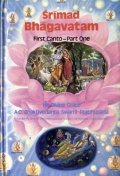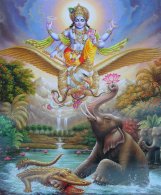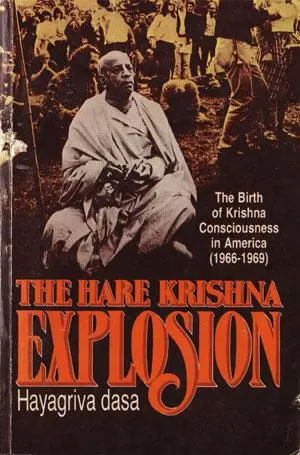click on image to enlarge
…In this material world we find that everything is temporary. It comes into being, stays for some time, produces some by-products, dwindles and then vanishes. That is the law of the material world, whether we use as an example this body, or a piece of fruit or anything. But beyond this temporary world there is another world of which we have information. This world consists of another nature which is sanātana, eternal. (from the Introduction to the Bhagavad-gita As It Is)
The abode of Lord Śrī Kṛṣṇa is described in the Bhagavad-gītā, Fifteenth Chapter, sixth verse:
na tad bhāsayate sūryo na śaśāṅko na pāvakaḥ
yad gatvā na nivartante tad dhāma paramaṁ mama
“That abode of Mine is not illumined by the sun or moon, nor by electricity. And anyone who reaches it never comes back to this material world.” (Bg. 15.6)
This verse gives a description of that eternal sky. Of course we have a material conception of the sky, and we think of it in relationship to the sun, moon, stars and so on, but in this verse the Lord states that in the eternal sky there is no need for the sun nor for the moon nor fire of any kind because the spiritual sky is already illuminated by the brahmajyoti, the rays emanating from the Supreme Lord. We are trying with difficulty to reach other planets, but it is not difficult to understand the abode of the Supreme Lord. This abode is referred to as Goloka. In the Brahma-saṁhitā it is beautifully described: Goloka eva nivasaty akhilātma-bhūtaḥ. The Lord resides eternally in His abode Goloka, yet He can be approached from this world, and to this end the Lord comes to manifest His real form, sac-cid-ānanda-vigraha. When He manifests this form, there is no need for our imagining what He looks like. To discourage such imaginative speculation, He descends and exhibits Himself as He is, as Śyāmasundara. Unfortunately, the less intelligent deride Him because He comes as one of us and plays with us as a human being. But because of this we should not consider that the Lord is one of us. It is by His potency that He presents Himself in His real form before us and displays His pastimes, which are prototypes of those pastimes found in His abode.
In the effulgent rays of the spiritual sky there are innumerable planets floating. The brahmajyoti emanates from the supreme abode, Kṛṣṇaloka, and the ānandamaya-cinmaya planets, which are not material, float in those rays. The Lord says, na tad bhāsayate sūryo na śaśāṅko na pāvakaḥ yad gatvā na nivartante tad dhāma paramaṁ mama. One who can approach that spiritual sky is not required to descend again to the material sky. In the material sky, even if we approach the highest planet (Brahmaloka), what to speak of the moon, we will find the same conditions of life, namely birth, death, disease and old age. No planet in the material universe is free from these four principles of material existence. Therefore the Lord says in Bhagavad-gītā, ābrahma-bhuvanāl lokāḥ punar āvartino ‘rjuna. The living entities are traveling from one planet to another, not by mechanical arrangement but by a spiritual process. This is also mentioned: yānti deva-vratā devān pitṝn yānti pitṛ-vratāḥ. No mechanical arrangement is necessary if we want interplanetary travel. The Gītā instructs: yānti deva-vratā devān. The moon, the sun and higher planets are called svargaloka. There are three different statuses of planets: higher, middle and lower planetary systems. The earth belongs to the middle planetary system. Bhagavad-gītā informs us how to travel to the higher planetary systems (devaloka) with a very simple formula: yānti deva-vratā devān. One need only worship the particular demigod of that particular planet and in that way go to the moon, the sun or any of the higher planetary systems.
Yet Bhagavad-gītā does not advise us to go to any of the planets in this material world because even if we go to Brahmaloka, the highest planet, through some sort of mechanical contrivance by maybe traveling for forty thousand years (and who would live that long?), we will still find the material inconveniences of birth, death, disease and old age. But one who wants to approach the supreme planet, Kṛṣṇaloka, or any of the other planets within the spiritual sky, will not meet with these material inconveniences. Amongst all of the planets in the spiritual sky there is one supreme planet called Goloka Vṛndāvana, which is the original planet in the abode of the original Personality of Godhead Śrī Kṛṣṇa. All of this information is given in Bhagavad-gītā, and we are given through its instruction information how to leave the material world and begin a truly blissful life in the spiritual sky.
In the Fifteenth Chapter of the Bhagavad-gītā, the real picture of the material world is given. It is said there:
ūrdhva-mūlam adhaḥ-śākham aśvatthaṁ prāhur avyayam
chandāṁsi yasya parṇāni yas taṁ veda sa veda-vit
“The Supreme Lord said: There is a banyan tree which has its roots upward and its branches down, and the Vedic hymns are its leaves. One who knows this tree is the knower of the Vedas.” (Bg. 15.1)
Here the material world is described as a tree whose roots are upwards and branches are below. We have experience of a tree whose roots are upward: if one stands on the bank of a river or any reservoir of water, he can see that the trees reflected in the water are upside down. The branches go downward and the roots upward. Similarly, this material world is a reflection of the spiritual world. The material world is but a shadow of reality. In the shadow there is no reality or substantiality, but from the shadow we can understand that there is substance and reality. In the desert there is no water, but the mirage suggests that there is such a thing as water. In the material world there is no water, there is no happiness, but the real water of actual happiness is there in the spiritual world.
The Lord suggests that we attain the spiritual world in the following manner:
nirmāna-mohā jita-saṅga-doṣā
adhyātma-nityā vinivṛtta-kāmāḥ
dvandvair vimuktāḥ sukha-duḥkha-saṁjñair
gacchanty amūḍhāḥ padam avyayaṁ tat
That padam avyayam or eternal kingdom can be reached by one who is nirmāna-moha. What does this mean? We are after designations. Someone wants to become a son, someone wants to become Lord, someone wants to become the president or a rich man or a king or something else. As long as we are attached to these designations, we are attached to the body because designations belong to the body. But we are not these bodies, and realizing this is the first stage in spiritual realization. We are associated with the three modes of material nature, but we must become detached through devotional service to the Lord. If we are not attached to devotional service to the Lord, then we cannot become detached from the modes of material nature. Designations and attachments are due to our lust and desire, our wanting to lord it over the material nature. As long as we do not give up this propensity of lording it over material nature, there is no possibility of returning to the kingdom of the Supreme, the sanātana-dhāma. That eternal kingdom, which is never destroyed, can be approached by one who is not bewildered by the attractions of false material enjoyments, who is situated in the service of the Supreme Lord. One so situated can easily approach that supreme abode. (from the Introduction to the Bhagavad-gita As It Is)














